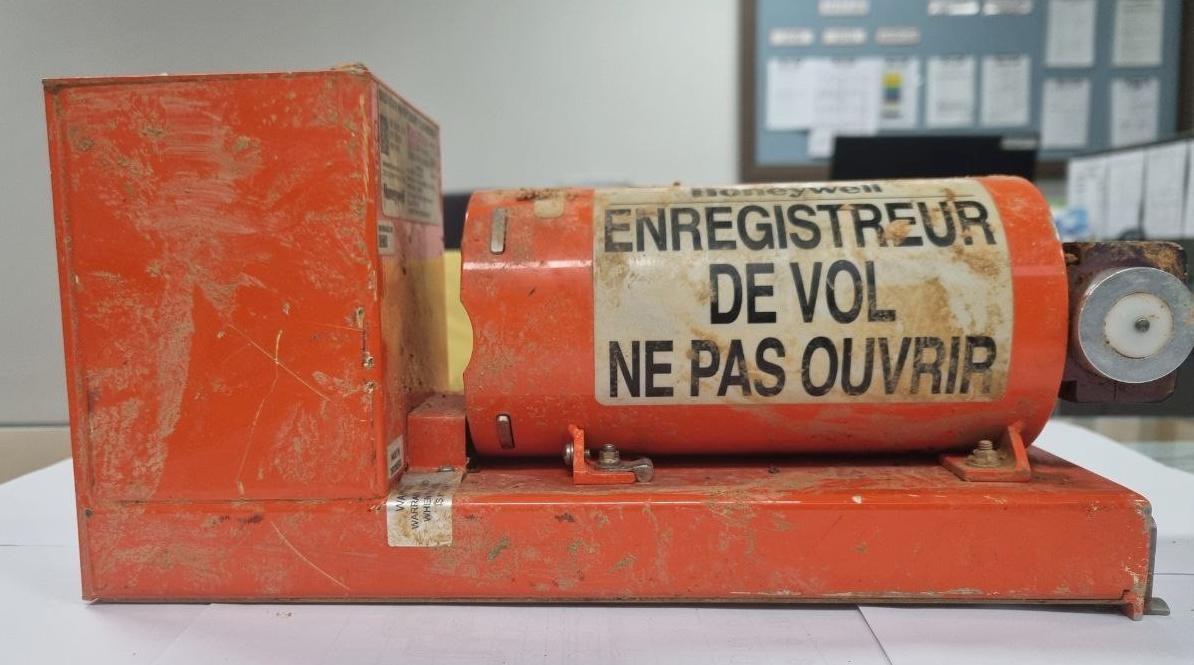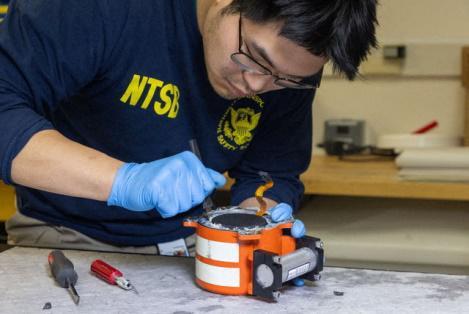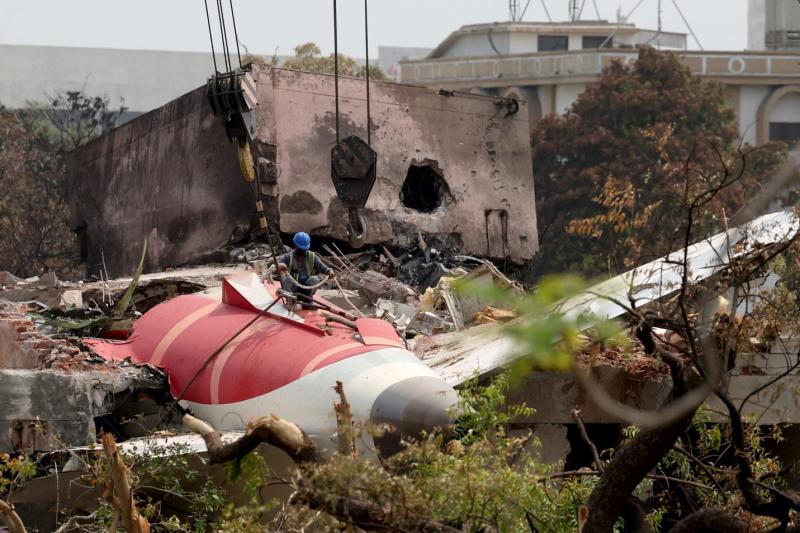A preliminary finding into last month’s Air India plane crash has suggested the aircraft’s fuel control switches were turned off, starving the engines of fuel and causing a loss of engine thrust shortly after takeoff.
The report, issued by India’s Aircraft Accident Investigation Bureau on Saturday last week, also found that one pilot was heard on the cockpit voice recorder (CVR) asking the other why he cut off the fuel in the flight’s final moment. The other pilot replied he had not done so.
The Air India flight — a Boeing 787-8 Dreamliner — crashed on June 12 and killed at least 260 people, including 19 on the ground, in the northwestern city of Ahmedabad. Only one passenger survived the crash, one of India’s worst aviation disasters.

Photo: Ministry of Land, Infrastructure and Transport, South Korea / 照片:南韓國土交通部
The report based its finding on the data recovered from the plane’s black boxes — combined CVRs and flight data recorders.
Here is an explanation of what black boxes are and what they can do:
WHAT ARE BLACK BOXES?

Photo: Reuters / 照片:路透
The CVR and the flight data recorder are tools that help investigators reconstruct the events that lead up to a plane crash.
They’re orange in color to make them easier to find in a wreckage, sometimes at considerable ocean depths. They’re usually installed a plane’s tail section, which is considered the most survivable part of the aircraft, according to the National Transportation Safety Board’s (NTSB) Web site.
WHAT DOES THE CVR DO?

Photo: Reuters / 照片:路透
The CVR collects radio transmissions and sounds such as the pilot’s voices and engine noises, according to the NTSB Web site.
Depending on what happened, investigators may pay close attention to the engine noise, stall warnings and other clicks and pops, the NTSB said. And from those sounds, investigators can often determine engine speed and the failure of some systems.
Investigators can also listen to conversations between pilots and crew and communications with air traffic control. Experts make a meticulous transcript of the voice recording, which can take up to a week.
WHAT DOES THE FLIGHT DATA RECORDER DO?
The flight data recorder monitors a plane’s altitude, airspeed and heading, according to the NTSB. Those factors are among at least 88 parameters that newly built planes must monitor.
Some can collect the status of more than 1,000 other characteristics, from a wing’s flap position to the smoke alarms. The NTSB said it can generate a computer animated video reconstruction of the flight from the information collected.
WHAT ARE THE ORIGINS OF THE BLACK BOX?
At least two people have been credited with creating devices that record what happens on an airplane.
One is French aviation engineer Francois Hussenot. In the 1930s, he found a way to record a plane’s speed, altitude and other parameters onto photographic film, according to the Web site of European plane-maker Airbus.
In the 1950s, Australian scientist David Warren came up with the idea for the CVR, according to his 2010 AP obituary.
Warren had been investigating the crash of the world’s first commercial jet airliner, the Comet, in 1953, and thought it would be helpful for airline accident investigators to have a recording of voices in the cockpit, the Australian Department of Defence said in a statement after his death.
Warren designed and constructed a prototype in 1956, although it took several years before officials understood just how valuable the device could be and began installing them in commercial airlines worldwide.
WHY THE NAME OF ‘BLACK BOX’?
Some have suggested that it stems from Hussenot’s device because it used film and “ran continuously in a light-tight box, hence the name ‘black box,’” according to Airbus, which noted that orange was the box’s chosen color from the beginning to make it easy to find.
Other theories include the boxes turning black when they get charred in a crash, the Smithsonian Magazine wrote in 2019.
The media continues to use the term, the magazine wrote, “because of the sense of mystery it conveys in the aftermath of an air disaster.”
(AP)
上月發生的印度航空墜機空難,初步調查結果顯示,飛機的燃油控制開關被關閉,導致引擎燃油不足,並在起飛後不久失去動力。
印度航空事故調查局上週六發布的報告還發現,座艙語音記錄器在飛行的最後一刻錄到,一名機師問另一機師為何切斷燃油,他回答說他沒有。
這架印度航空波音787-8型夢幻客機,6月12日在印度西北部城市阿默達巴德墜毀,造成至少260人罹難,其中包括19名地面人員。只有一名乘客倖存,這是印度史上最嚴重的空難之一。
該調查報告是根據飛機「黑盒子」(座艙語音記錄器與飛航資料記錄器之組合)中的資料所做出。
以下說明何為黑盒子,及其功能:
「黑盒子」是什麼?
座艙語音記錄器,以及飛航資料記錄器,是幫助調 查人員重建飛機失事事件的工具。
「黑盒子」是橘色的,以便更容易在飛機殘骸,甚至在深海中找到。根據美國國家運輸安全委員會(NTSB)網站,黑盒子通常安裝於飛機尾部,這被認為是飛機最容易倖存的部分。
座艙語音記錄器的功能是什麼?
根據NTSB網站,座艙語音記錄器會收集無線電傳輸及聲音,例如飛行員的聲音和引擎噪音。
根據發生的情況,調查人員可能會密切注意引擎噪音、失速警告,以及其他喀噠聲和爆裂聲。透過這些聲音,調查人員通常可以確定引擎轉速和某些系統的故障情況。
機師和機組人員之間的對話,以及與地面航管人員的通話也可聽到。專家會將錄下來的語音做成鉅細靡遺的文字紀錄,這可能需費時長達一週。
飛航資料記錄器的功能是什麼?
根據NTSB的介紹,飛航資料記錄器可監控飛機的高度、空速及航向。這些因素是新造飛機必須監控的至少88個參數之一。
有些記錄器可收集一千多種其他部位的狀態,從機翼的襟翼位置到煙霧警報器。NTSB表示,它可以根據收集到的資料生成電腦動畫影片,重建飛行過程。
黑盒子的由來是什麼?
至少有兩個人被認為發明了記錄飛機狀況的裝置。
一位是法國航空工程師弗朗索瓦・余瑟諾。歐洲飛機製造商空中巴士(Airbus)的網站介紹說,余瑟諾在1930年代找到一種將飛機的速度、高度和其他參數記錄在底片上的方法。
另外一位是澳洲科學家大衛・沃倫。美聯社2010年為他刊登的訃告寫道,沃倫在1950年代發想出座艙語音記錄器的概念。
根據澳洲國防部在沃倫去世後發布的聲明,沃倫在調查世界第一款商用噴射客機「彗星」1953年墜毀事故時,他萌生出一想法,認為記錄駕駛艙內的聲音會對航空事故的調查有所幫助。
沃倫1956年設計並製造了一個原型機。但數年之後官員才意識到該設備的價值,並開始用於全球民航線。
為何稱作「黑盒子」?
空中巴士表示,有人認為這名稱源自余瑟諾的裝置,因為它使用底片,「在一個不透光的盒子裡連續運轉,因此得名『黑盒子』」。空中巴士指出,為了便於搜尋,黑盒子從一開始就被設定為橘色。
《史密森尼雜誌》在2019年撰文稱,其他的說法還有,這些盒子在墜機事故中燒焦後會變黑。該雜誌寫道,媒體仍在使用「黑盒子」這個詞,「因為它在空難後傳達了一種神秘感」。
(台北時報林俐凱編譯)

The third-hottest July worldwide ended a string of record-breaking temperatures last month, but many regions were still devastated by extreme weather amplified by global warming, the European climate monitoring service said Thursday last week. Heavy rains flooded Pakistan and northern China; Canada, Scotland and Greece struggled to tame wildfires intensified by persistent drought; and many nations in Asia and Scandinavia recorded new average highs for the month. “Two years after the hottest July on record, the recent streak of global temperature records is over,” Carlo Buontempo, director of the EU’s Copernicus Climate Change Service, said in a statement. “But that

Whale sharks are the largest species of fish in the world. They aren’t related to whales, but take their name due to their enormous size. At full maturity, whale sharks measure around nine or 10 meters long and can weigh from 15,000 to 40,000 kilograms. Whale sharks live in warm waters, with about 75% of them found in the Indo-Pacific region. They can migrate thousands of kilometers to different feeding grounds, but at a slow speed of 5 km/h on average. Whale sharks have a broad, flat head and are typically brown or gray in color. Their distinguishing characteristic

Peacocks are among the most beautiful birds in the world. Their bright feathers and graceful movements have fascinated humans for centuries. These magnificent creatures belong to the pheasant family and are found in regions across Asia and Africa. Let’s explore peacocks’ unique characteristics and cultural significance. There are three main species of peacock: the well-known Indian peafowl, native to South Asia; the endangered green peafowl from Southeast Asia; and the rare Congo peafowl, found in African rainforests. Although the term “peacock” technically refers only to males, many people use it for both sexes. Male peacocks display their colorful tail feathers, which

Continued from yesterday(延續自昨日) https://www.taipeitimes.com/News/lang Whale shark reproduction has long been a mystery for scientists. However, a significant discovery in 1995 off the eastern coast of Taiwan provided valuable insights. Researchers examined a pregnant female of the species and found over 300 embryos inside her body, ranging from about 40 to 60 cm in length. This discovery revealed that whale sharks are ovoviviparous. Instead of laying eggs in the ocean, the mother carries them internally until they hatch, giving birth to fully developed live young. Since the eggs don’t hatch all at once, embryos at different stages of development can all exist within